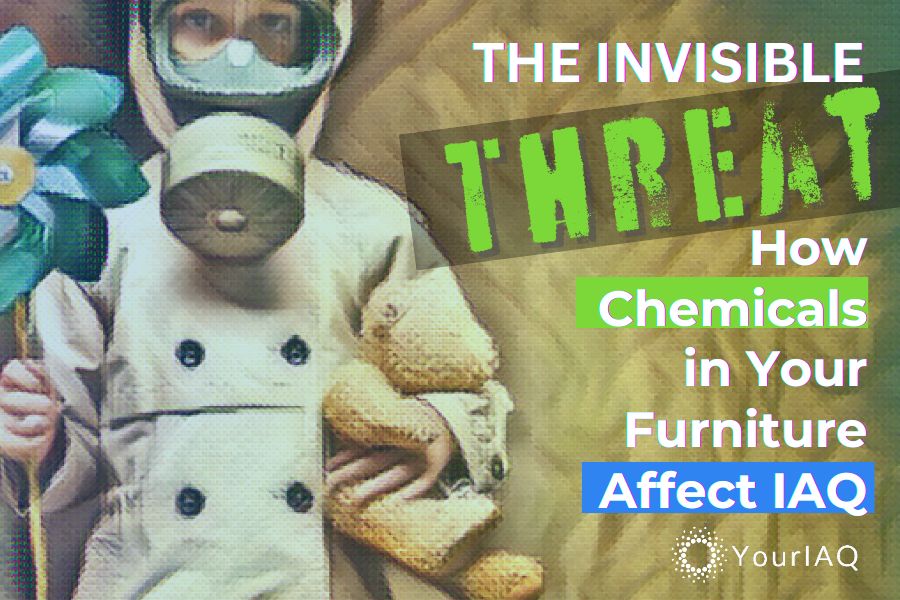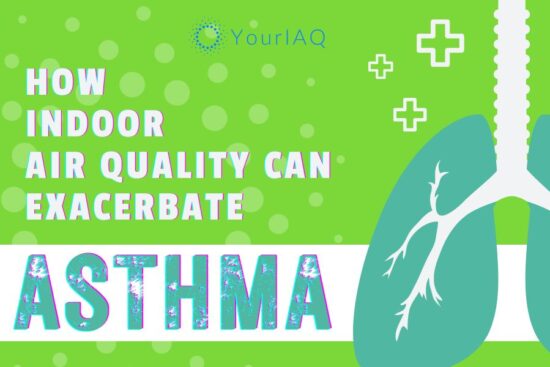
Most of us think of our homes as safe havens. But the shocking truth is, the air we breathe indoors could be more polluted than the air outside. Surprisingly, a major source of this pollution can be your furniture. Chemicals used in manufacturing couches, chairs, and tables silently release harmful substances into your home, potentially affecting your health.
Imagine this: You buy a new sofa, excited to relax comfortably. But an odd smell – maybe a lingering headache or a scratchy throat – soon follows. You might not realize these are signs of exposure to harmful chemicals commonly used in furniture.
From flame retardant chemicals to VOCs and other concerning substances, your new sofa could silently release pollutants into your home. While the effects are often subtle at first, the long-term consequences of breathing in these chemicals could be severe, potentially even increasing your cancer risk.
Studies show that indoor air can be two to five times – sometimes even up to 100 times – more polluted than outdoor air [1]. Furniture plays a significant role in this, gradually releasing chemicals. Some of these chemicals, classified as carcinogens, are directly linked to increased cancer risk.
Let’s delve deeper into the specific chemicals found in furniture and how they can negatively impact the air we breathe in our homes.
Hidden Hazards: Chemicals in Common Furniture
Furniture is a staple in every home that defines comfort, style, and functionality. Let’s take a closer look at the range of chemicals often found in furniture and how they can cause health problems:
Formaldehyde in Furniture: What to Know
Formaldehyde is one of the most prevalent chemicals lurking in furniture. This colorless gas, known for its pungent smell, is used in resins and glues that bind together pressed wood products (particleboard, plywood, MDF).
It’s important to remember that formaldehyde can be found in a surprising variety of products in your home. These include cosmetics, permanent-press fabrics, carpets, and building materials.
Exposure to formaldehyde irritates the eyes, nose, and throat and can cause headaches. Long-term exposure increases the risk of certain cancers, as formaldehyde is a known carcinogen [2].
VOCs: More Than Just a Smell
Volatile Organic Compounds (VOCs) are responsible for that “new furniture smell” but their impact goes far beyond an odor.
VOCs are vast chemicals that easily evaporate into the air. In furniture, common VOCs include benzene, toluene, and xylene. These chemicals are found in
- paints
- finishes
- glues and
- fabrics
Short-term exposure to VOCs can cause headaches and dizziness and worsen respiratory conditions like asthma. Some VOCs are suspected carcinogens or have other long-term health risks [3].
See also: Understanding VOCs: The Hidden Threat in Your Home and What You Can Do About It
Flame Retardants: Necessary but Not Without Risk
Flame retardants are essential for slowing fire spread and are added to foam cushions and fabrics to meet fire safety standards. However, many older flame retardants have been phased out due to serious health concerns.
Polybrominated Diphenyl Ethers (PBDEs) and chlorinated Tris
PBDEs and chlorinated Tris are flame retardants linked to serious health concerns, including developmental problems, hormone disruption, and cancer.
Exposure to PBDEs during pregnancy and early childhood can have harmful effects on brain development, potentially leading to learning, memory, and behavioral issues [4]. Additionally, PBDEs are associated with thyroid disruption, and some evidence suggests a link to breast cancer [5].
While newer flame retardants are considered safer, concerns about their potential impact on our health remain – particularly with chemicals like organophosphate flame retardants.
*Tip: Whenever possible, choose furniture labeled as flame retardant-free.
PFAS: The “Forever Chemicals”
PFAS (per- and poly-fluoroalkyl substances), used to make fabrics stain- and water-resistant, are known as “forever chemicals.” This is because they don’t easily break down, accumulating in our bodies and the environment.
Studies link PFAS exposure to hormone disruption, immune system problems, various cancers, and other serious health effects [6]. Their persistence means these chemicals can linger in drinking water, food, and even household dust.
Phthalates: Plastic Softeners with Health Concerns
Phthalates are used to make plastics flexible, and they can be found in vinyl furniture components or plastic coverings. Unfortunately, these chemicals are linked to hormone disruption and reproductive issues [7].
Antimicrobials: Hidden Risks in Treated Furniture
Sometimes added to furniture to kill bacteria and fungi, chemicals like triclosan and triclocarban raise concerns about contributing to the rise of antibiotic-resistant “superbugs.” This is because they can leave behind the strongest bacteria, allowing them to multiply and become resistant to traditional antibiotics.
Heavy Metals: Toxic Legacies and Ongoing Dangers
Historically used in paints, lead is highly toxic, especially to children. Chromium, used in leather tanning and metal finishes, is an irritant, and some forms can cause cancer [8].
Preservatives: Protecting Wood, But at What Cost?
Wood furniture, especially outdoor pieces, might be treated with preservatives like pentachlorophenol (PCP) or copper naphthenate for a longer lifespan [9]. However, these chemicals raise health and environmental concerns, prompting many to seek untreated or naturally decay-resistant wood options.
Dyes and Finishes: More Than Meets the Eye
Creating vibrant colors and finishes for furniture can involve VOCs, sometimes heavy metals, and potentially harmful dyes, like Azo dyes, within the pigments.
Read more: 8 Everyday Household Items You Didn’t Know Were Polluting Your Air
How Chemicals in Your Furniture Affect IAQ (and Your Health)
The chemicals hidden within your furniture don’t stay put. Through an off-gassing process, they gradually escape into the air you breathe.
How Off-Gassing Works
Off-gassing is a process where chemicals in furniture escape into the air we breathe. These chemicals are commonly found in pressed wood, foam, fabrics, and finishes used in everyday furniture.
Over time, these substances evaporate slowly or break into microscopic particles, turning from solid or liquid forms into gas and becoming part of the indoor air environment.
Factors like heat, humidity, and ventilation significantly influence the rate at which off-gassing occurs. Typically, new furniture releases chemicals more rapidly in the initial period after manufacture, gradually decreasing over time.
Health Impacts: More Than Just Annoyance
While we often think of the smell of new furniture as the biggest issue, the health impacts of chemical off-gassing can be far more serious.
Short-Term Effects
Exposure to off-gassing chemicals can cause:
- Headaches, dizziness, nausea: These are common reactions to chemicals irritating the body.
- Eye, nose, and throat irritation: Many VOCs and formaldehyde cause burning sensations, dryness, or increased mucus production [10].
- Worsening of asthma or allergies: People with these pre-existing conditions are especially sensitive to airborne irritants released from furniture. Attacks or flare-ups can be triggered.
Long-Term Risks
The biggest concern is the long-term health effects of continued exposure, including:
- Increased cancer risk (formaldehyde and other carcinogens)
- Developmental problems in children
- Hormone disruption
- Weakened immune system
5 Solutions: Choosing Safer, Eco-Friendly Furniture
Knowing that you can create a healthier home by making informed furniture choices is empowering. Here’s where to start:
1. Certifications Matter
Certifications are one of the best ways to find safer furniture for your home. This is because products are independently tested to ensure they meet strict standards for low chemical emissions.
GREENGUARD Gold is the most widely recognized certification, but there are others to look for. Here are a few of the most important:
- GREENGUARD Gold: This certification has strict standards for low chemical emissions, covering various VOCs and other pollutants.
- Oeko-Tex Standard 100: This certification ensures that fabrics have been tested for harmful substances, making them safer choices for upholstery.
- Cradle to Cradle: This certification goes beyond just chemical safety, indicating products are designed for sustainability throughout their lifecycle.
- Forest Stewardship Council (FSC): FSC-certified wood comes from responsibly managed forests, promoting responsible practices and protecting natural resources.
How to Research Brands
Finding safer furniture options takes a bit of investigation, but it’s worth the effort. Here’s how to get started:
- Tip #1: Certification Websites: Organizations like GREENGUARD have searchable certified products and brand databases.
- Tip #2: Manufacturer Websites: Reputable companies will have information on their sustainability practices, material choices, and any certifications they hold.
- Tip #3: Eco-Friendly Retailers: Specialty stores focused on non-toxic furniture are a wealth of knowledge. Their staff can guide you towards better choices.
- Tip #4: Targeted Searches: Looking specifically for “[type of furniture] + GREENGUARD Gold” (or another certification) can narrow down your search.
2. Choose Solid Wood
Opt for furniture made from solid wood rather than pressed wood products (particleboard, MDF) when possible. Solid wood naturally off-gasses less and tends to be more durable. Be sure to ask about finishes and any wood treatments that might have been used.
*Tip: In addition to choosing solid wood furniture, look for “no-added formaldehyde” (NAF) or “ultra-low emitting formaldehyde” (ULEF) labels on pressed wood products.
3. Go for Wool, Linen, and Organic Cotton
Choose upholstery fabrics like wool, linen, or organic cotton. These natural fibers are less likely to be heavily treated with chemicals than many synthetic fabrics. Look for labels like Oeko-Tex Standard 100, which indicate testing for harmful substances.
4. The Secondhand Advantage
Consider buying vintage or used furniture. Older pieces have often already done most of their initial off-gassing. This can be a budget-friendly way to find unique, high-quality items.
5. Let It Off-Gas (But Not in Your House)
When you bring new furniture into your home, allowing it to air out before using it is crucial. Doing so reduces exposure to the initial off-gassing of chemicals, often at its highest with new items.
Let new furniture air out in a garage, well-ventilated room, or outdoors for a few days. Remember, good ventilation in your home is crucial for improving indoor air quality and reducing the buildup of pollutants.
What About Existing Furniture?
Stay calm if you’re concerned about furniture you already own. Improving ventilation in your home is a key step. Houseplants that naturally filter the air can be helpful. Refinishing with safer products might be an option for high-concern items, depending on the piece.
Where to Find Better Options
- Online Resources: Stores like Medley Furniture, The Joinery, and Greenington specialize in eco-friendly and non-toxic furniture options – and there are more!
- Local Makers: Search online for [your city/region] + ‘furniture makers’ and look for those emphasizing natural materials and safe finishes. Local craft markets are also great for discovering these artisans. Working with a local maker allows for unique, personalized pieces.
The Invisible Threat: How Chemicals in Your Furniture Affect IAQ
For most of us, the furniture in our homes provides comfort and style. But the truth is that some furniture conceals hidden dangers – chemicals that harm our health and pollute the air we breathe.
Understanding this hidden threat empowers you to take control. Choosing furniture made with safer materials and finishes reduces exposure to harmful chemicals.
These conscious choices create a healthier home environment for you and your family, supporting a shift towards more sustainable and responsible furniture manufacturing.
FAQs About Chemicals in Furniture and IAQ
What are VOCs in furniture?
VOCs (Volatile Organic Compounds) are chemicals in furniture that can vaporize and pollute indoor air, posing health risks.
Which furniture emits more chemicals?
Pressed wood products and upholstered furniture often emit more VOCs due to adhesives and treatments.
How long does furniture off-gas chemicals?
Off-gassing can last months to years but is most intense in the first few weeks after manufacturing.
Is my old furniture still off-gassing?
Most off-gassing occurs in the first few years, but some chemicals might be released longer. The type of furniture finishes used, and how it’s been stored, play a role.
How can I improve air quality around older furniture?
The best approach is good ventilation in your home. Opening windows regularly and using air purifiers (especially ones with activated carbon filters) help reduce the buildup of chemicals in the air.
Should I replace my old furniture for health reasons?
If you have a piece that still has a strong odor (from formaldehyde or other chemicals), and you have young children or someone with sensitivities, replacement is the best option. In many cases, improving ventilation and air quality in your home is enough.
How do we identify harmful chemicals in furniture?
Look for low-emission labels like GREENGUARD or EcoLabel and research materials and brands for chemical use.
Can air purifiers remove furniture chemicals from the air?
Yes. Air purifiers with activated carbon filters can reduce VOCs and other chemicals in indoor air.
Are eco-friendly furniture options available for all types?
Yes, there are eco-friendly options for nearly all furniture types made from sustainable materials with fewer chemicals.
References
- [1] Indoor Air Quality. https://www.epa.gov/report-environment/indoor-air-quality
- [2] Formaldehyde. https://www.cancer.gov/about-cancer/causes-prevention/risk/substances/formaldehyde
- [3] Volatile Organic Compounds’ Impact on Indoor Air Quality. https://www.epa.gov/indoor-air-quality-iaq/volatile-organic-compounds-impact-indoor-air-quality#Health_Effects
- [4] Gibson, E. A., Siegel, E. L., Eniola, F., Herbstman, J. B., & Factor-Litvak, P. (2018). Effects of Polybrominated Diphenyl Ethers on Child Cognitive, Behavioral, and Motor Development. International journal of environmental research and public health, 15(8), 1636. https://doi.org/10.3390/ijerph15081636
- [5] Renzelli, V., Gallo, M., Morviducci, L., Marino, G., Ragni, A., Tuveri, E., Faggiano, A., Mazzilli, R., Natalicchio, A., Zatelli, M. C., Montagnani, M., Fogli, S., Giuffrida, D., Argentiero, A., Danesi, R., D’Oronzo, S., Gori, S., Franchina, T., Russo, A., Monami, M., … Silvestris, N. (2023). Polybrominated Diphenyl Ethers (PBDEs) and Human Health: Effects on Metabolism, Diabetes and Cancer. Cancers, 15(17), 4237. https://doi.org/10.3390/cancers15174237
- [6] Perfluoroalkyl and Polyfluoroalkyl Substances (PFAS). https://www.niehs.nih.gov/health/topics/agents/pfc
- [7] Abdo, N., Alajlouni, M., Hamadneh, J., & Alajlouni, A. M. (2023). Screening for phthalates biomarkers and its potential role in infertility outcomes in Jordan. Journal of Exposure Science & Environmental Epidemiology, 33(2), 273-282. https://doi.org/10.1038/s41370-022-00517-7
- [8] Hexavalent Chromium Compounds. https://www.cancer.gov/about-cancer/causes-prevention/risk/substances/chromium#:~:text=Which%20cancers%20are%20associated%20with,paranasal%20sinuses%20and%20nasal%20cavity.
- [9] Wood Preservatives and Components. http://npic.orst.edu/ingred/ptype/treatwood/types.html
- [10] Alford, K. L., & Kumar, N. (2021). Pulmonary Health Effects of Indoor Volatile Organic Compounds-A Meta-Analysis. International journal of environmental research and public health, 18(4), 1578. https://doi.org/10.3390/ijerph18041578






